After the stunning evening spent admiring stars and nebulae, and after a night spent in proper bed where I could have a decent rest, I was ready for a new day and a new excursion. This time it meant that we went on a whole-day tour to watch penguins. The trip first took us through semi-desert landscapes north of La Serena where we saw a solitary guanaco. We passed through some sections the surface of which was covered by scarce greenery and vegetation, and then the guide told us that there were underground rivers which only occasionally come up to the surface and then plants somehow manage to reach the water. In addition, we were told that there are actually a lot of plants that spend years and years in hibernation. On exceptionally rare occasions when there is rain here, the plants simply explode in the form of a myriad of flowers and the whole area turns into a motley blossom carpet. A couple of years ago I read that this actually happened, but unfortunately I was not there to enjoy the rare phenomenon first hand.
In December 2006 everything was in a deep vegetative sleep and our first destination was the shore near village Punta de Choros from where we went in a boat to visit the Pingüino de Humboldt National Reserve. The reserve includes three islands: Isla Choros, Isla Damas and Isla Chañaral. In addition to penguins, the trip was supposed to allow us to see some other interesting animals as well.
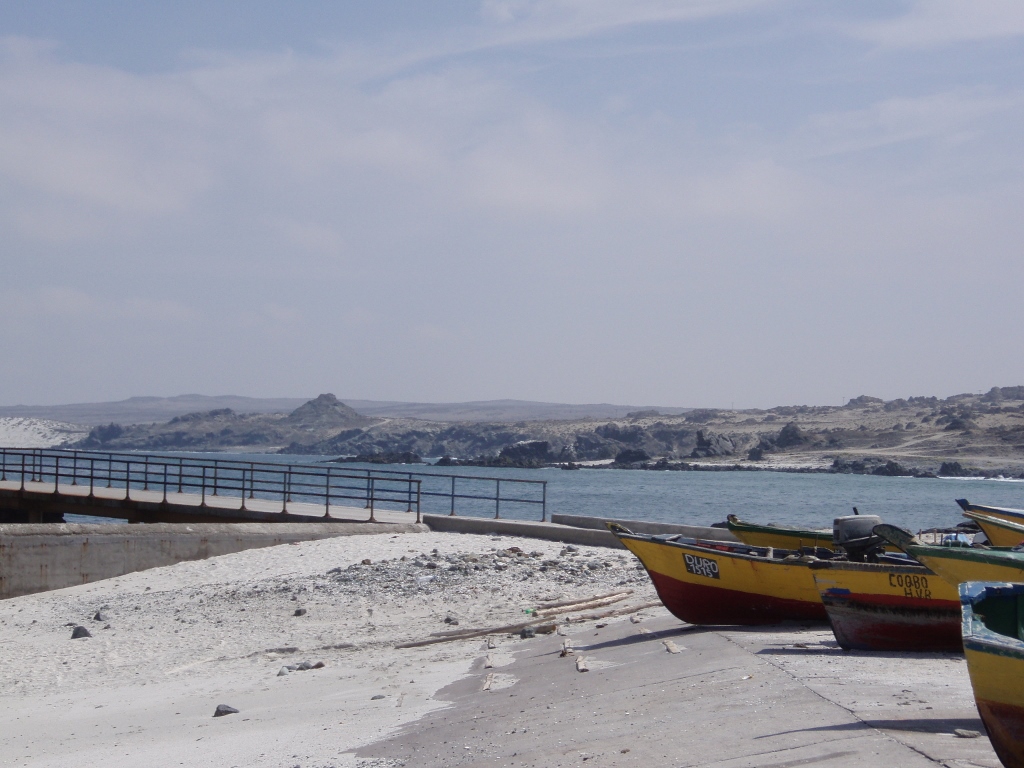 Shore within the Pingüino de Humboldt National Reserve
Shore within the Pingüino de Humboldt National Reserve
From the shore, while we were waiting to embark the boat, we could see islands of Choros and Damas, which were our main destinations. After we had set off from the coast, we were soon joined by dolphins that jumped around us. And then at one point the guide shouted: “Whale!” and a boat chase started across the open waters. Then the boat slowed down and we moved at a low pace or just floated in one spot. On the surface of the water, we could see dolphins peering out a little and then disappear again. I even stood up in the boat with the aim to have a better view and in the distance I could see the back of a whale leisurely arching above the surface of the ocean before going back into the depths. Other than that, we could see nothing else in the rippled water. And then, close to us we saw a reddish patch. With an indescribably enormous enthusiasm, the guide started telling us that it was a female whale giving birth and I think he was the only one who could see anything, but that did not stop him from showing us, a little to the left and a little to the right, that there was a baby whale and everything was resonating with his completely eagerness-filled shouts: “Baby! Baby! Here’s a baby!” pointing at where this was apparently happening. The rest of us in the boat were like on a tennis court, turning our heads to the left, then to the right, but nobody saw anything and we only had confused expressions on our faces feeling inadequate for not seeing such a sublime act we were allegedly witnesses to. Admittedly, the fact was that there was this reddish something floating on the surface, but one of the other visitors from the boat claimed these was some plankton. I have no clue what it really was, but Sneza and I eventually had a good laugh and over the next couple of days we kept shouting with a lot of enthusiasm: “Baby! Baby! Here’s a baby!”
Then we gave up on whales and went to the island of Choros, which we circled around, watching sea lions lying around the rocks.
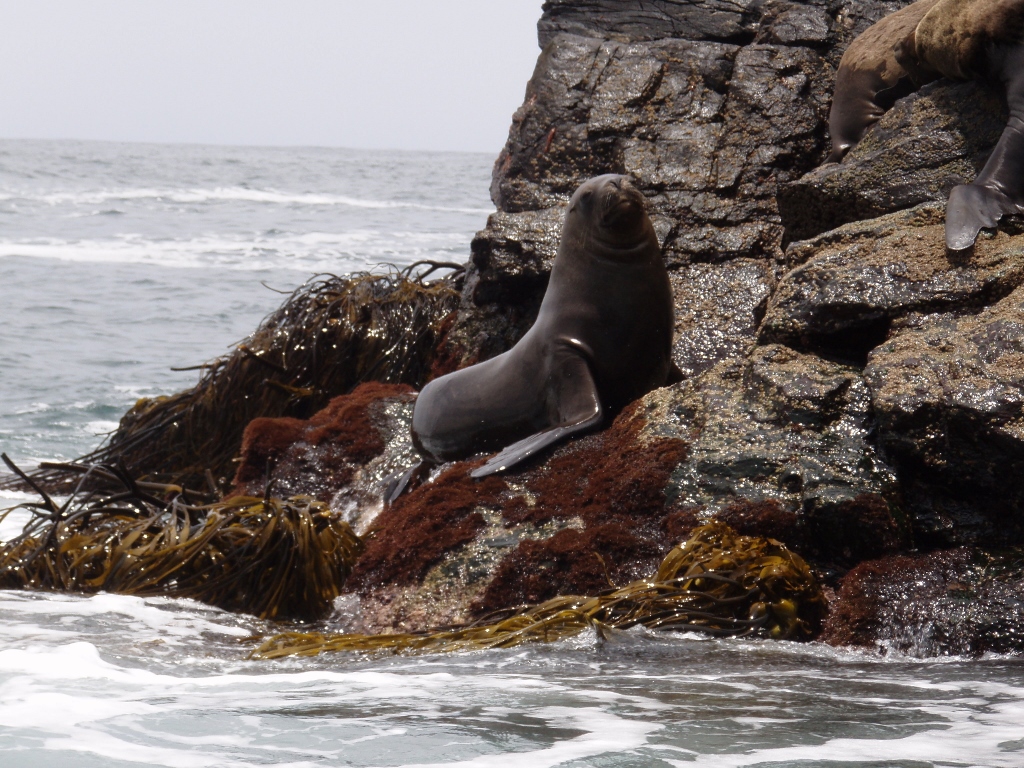 A sea lion at the Isla Choros, Pingüino de Humboldt National Reserve
A sea lion at the Isla Choros, Pingüino de Humboldt National Reserve
We also went to a section of the island where a rocky slope rises from the ocean and there we learned that penguins nest on the top and each day they go up and down this slope, between their nests and the ocean where the food is. There were around 3800 Humboldt penguins living on the island at the time and this species grows up to 50 cm in height tops. We also saw some other flying birds that nest around, most of which were boobies.
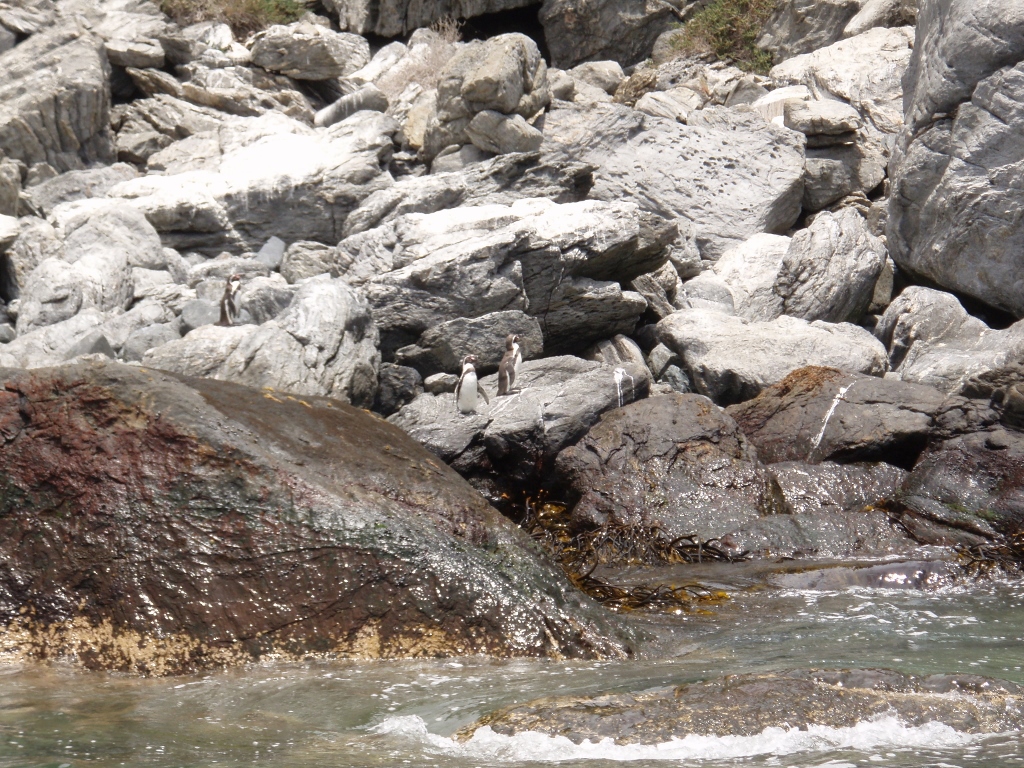 Humboldt penguins on Isla Choros, Pingüino de Humboldt National Reserve
Humboldt penguins on Isla Choros, Pingüino de Humboldt National Reserve
And then we went to Isla Damas were we disembarked and walked around the island for some 40 minutes. While we were going to Isla Damas, we were shown a shell which is locally called loco and which we got from some fishermen we passed by. Apparently, this type of shell was going to be included in our lunch a little later. In its live version, it did not seem like much.
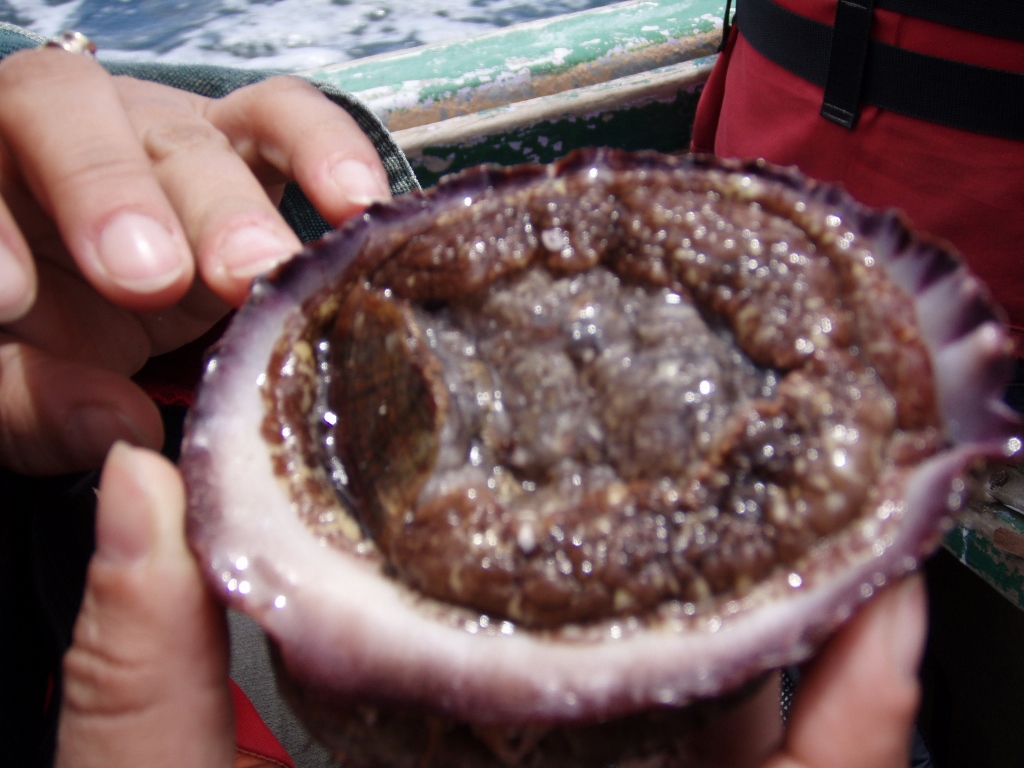 Loco shell
Loco shell
Isla Damas is a very pretty and interesting place. On the one hand, it appears rather dry and its vegetation in the form of low shrubs, cacti and some grasses was greyish and arid.
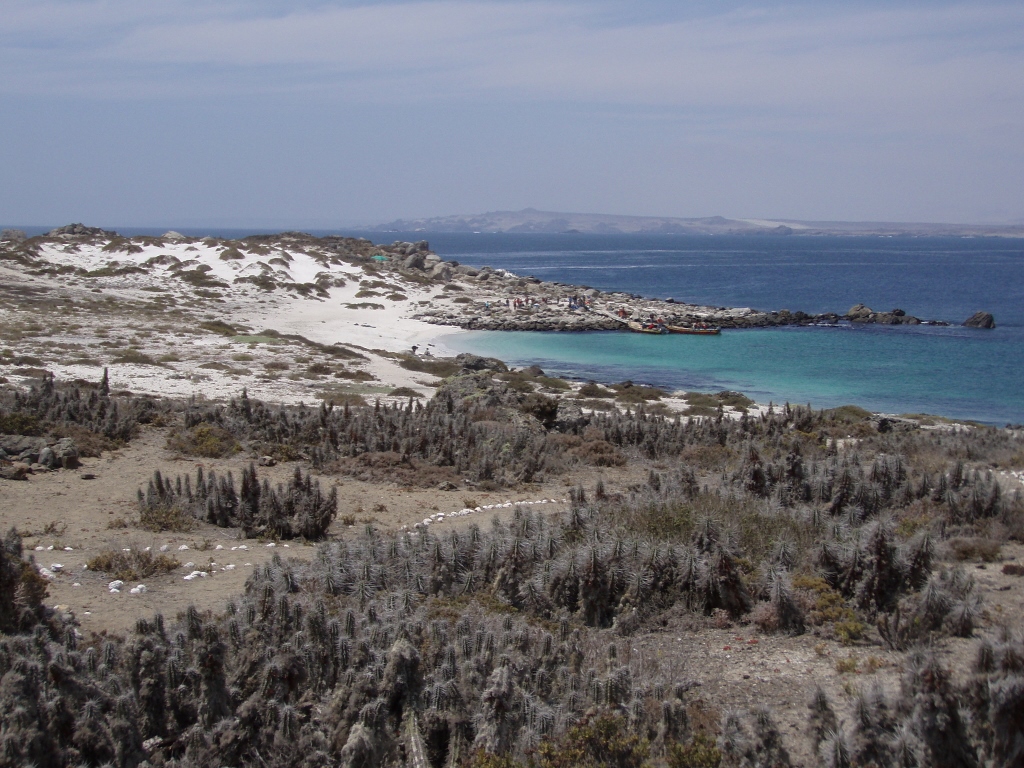 Isla Damas
Isla Damas
On the other hand, however, the little bay at the end of which we disembarked had a lovely white-sand beach and the water was of attractive turquoise colour. Still, Sneza and I remained in the sweaters we had on, while a lady from Denmark went for a swim. She said the water in Copenhagen in which she apparently swam regularly was colder than this one here. I have not tried either and I’m quite content with it, but this lady was truly happy. For me, it was enough to sit down on the sand and enjoy the warm sun for a while. On the nearby rocks, black cormorants were drying up their wings.
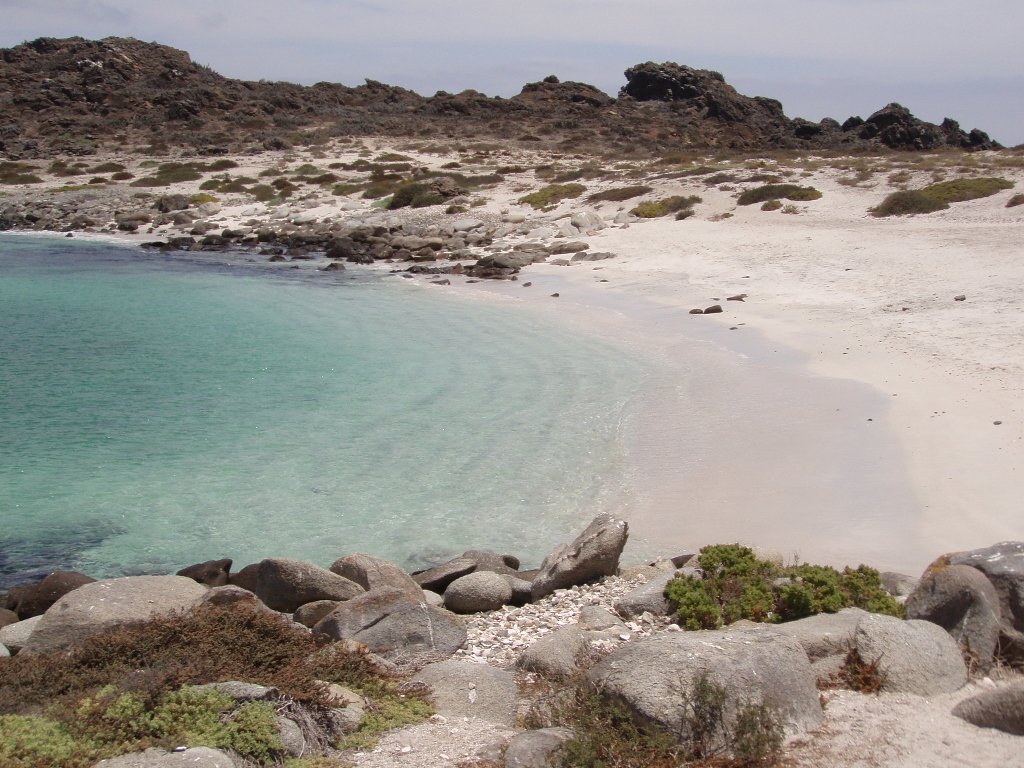 Isla Damas
Isla Damas
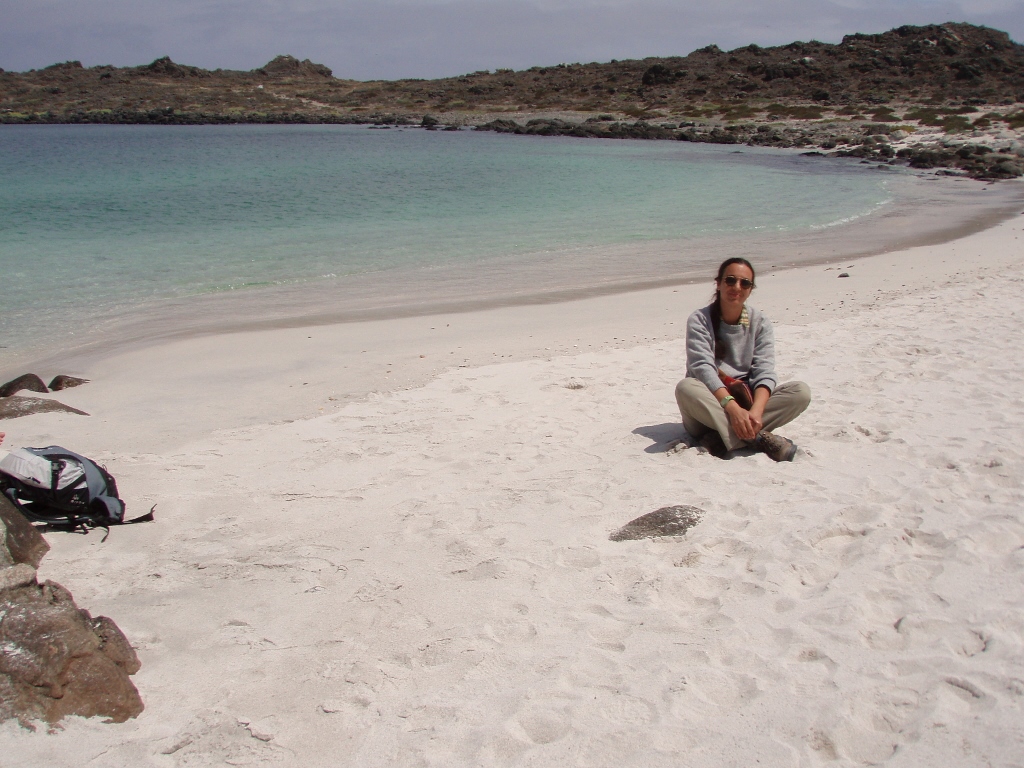 Isla Damas
Isla Damas
When we returned to the shore, we came across some fishermen who were “working” on a larger piece of rock they had fetched from the ocean. This all concerned a procedure for getting out a piura, a tunicate living in hollows that may be found in stones and rocks. We, just coincidental passers-by, gathered around them and watched the whole thing. Since I joked a little with those fishermen, the one getting the piura out offered to me, as a challenge, to try it. It was a question of honour, as well as courage, but I stepped up. I swallowed a large piece of raw and freshest possible piura, but so quickly that I have no idea what it tasted like.
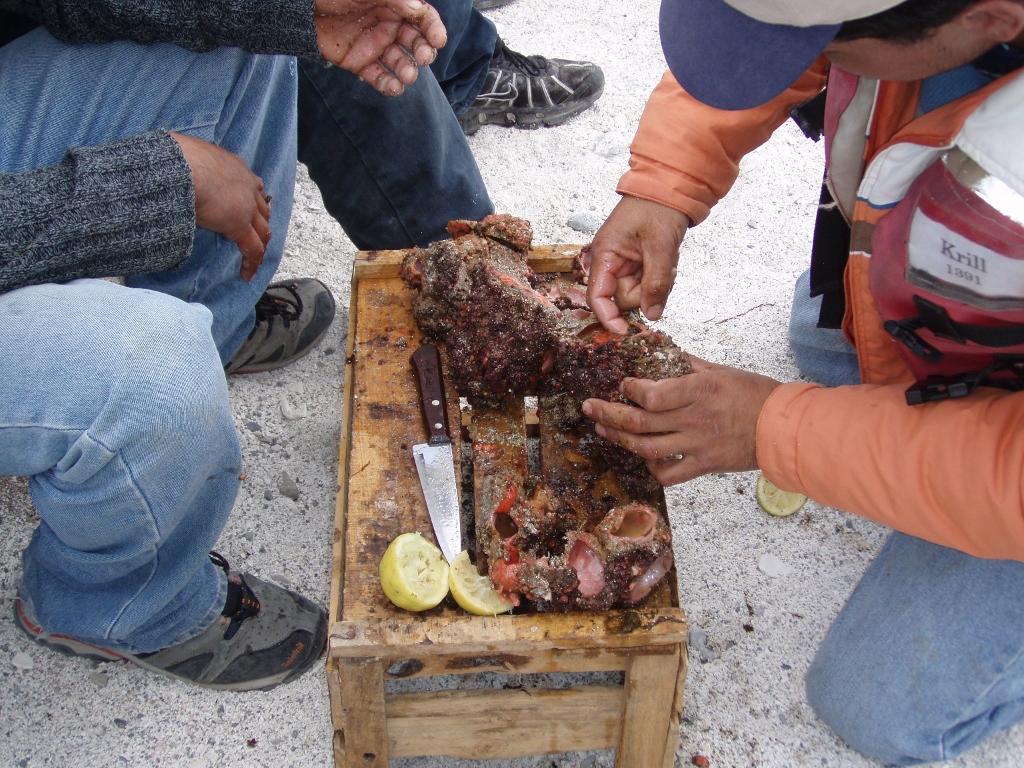 Extracting a piura out of a rock
Extracting a piura out of a rock
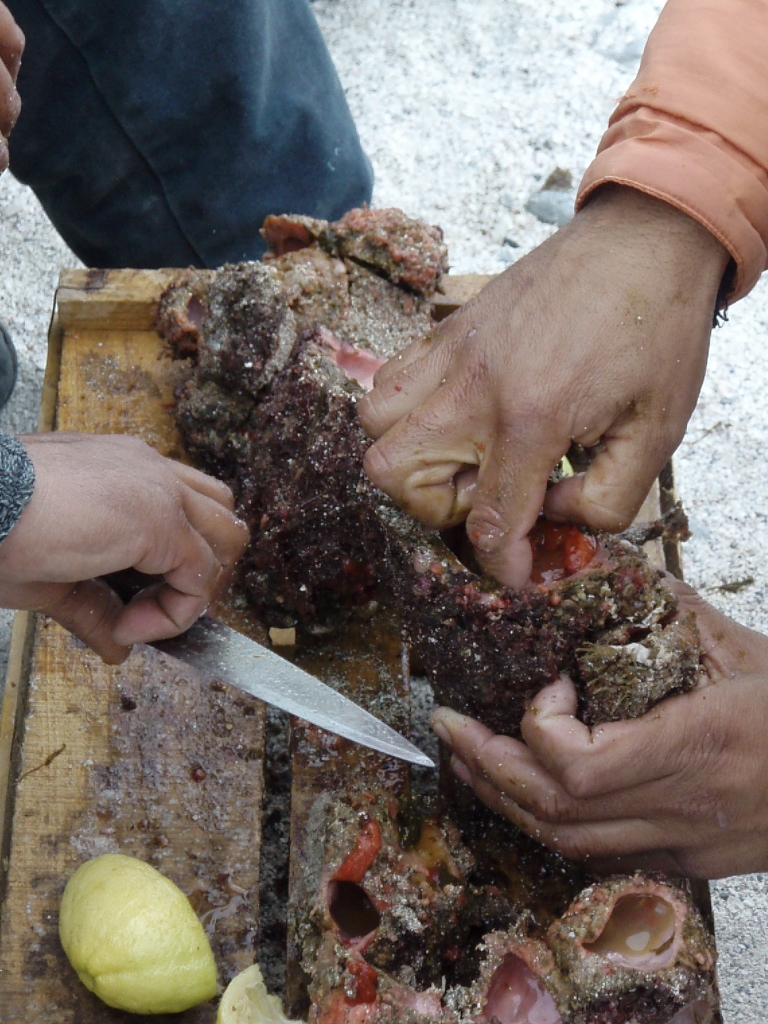 Extracting a piura out of a rock
Extracting a piura out of a rock
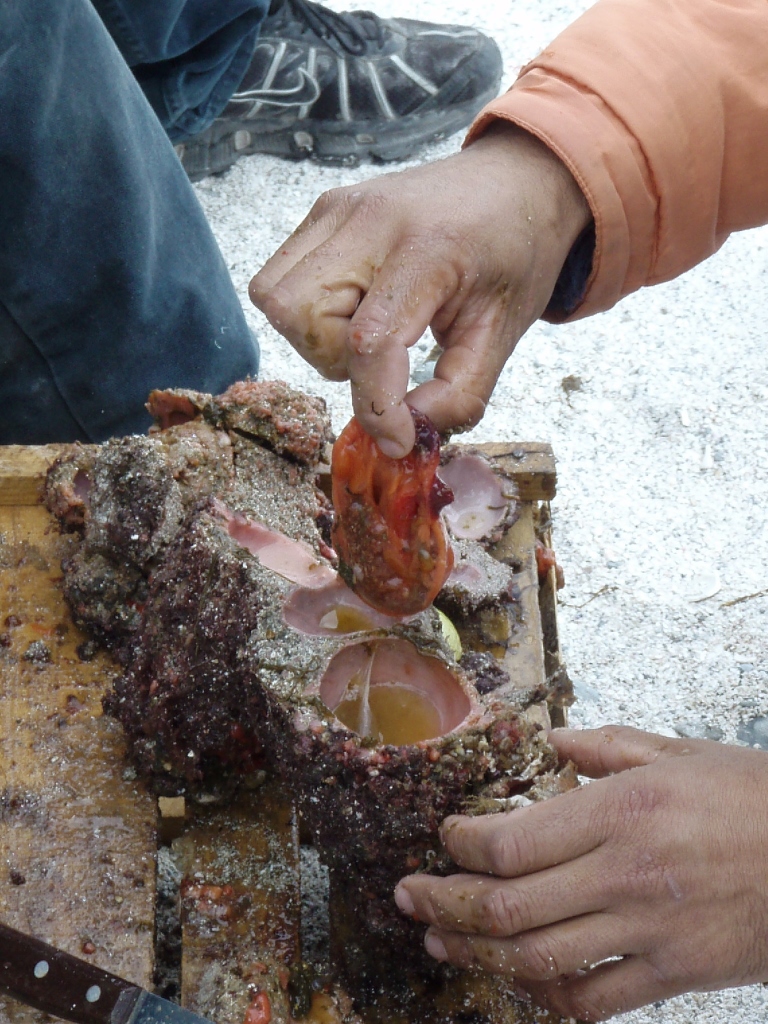 Extracting a piura out of a rock, I gulped down two-thirds of this piece
Extracting a piura out of a rock, I gulped down two-thirds of this piece
Still, it was an excellent starter for after this we went straight to a restaurant to have lunch. There we also tried empanadas with loco shell I have already mentioned.
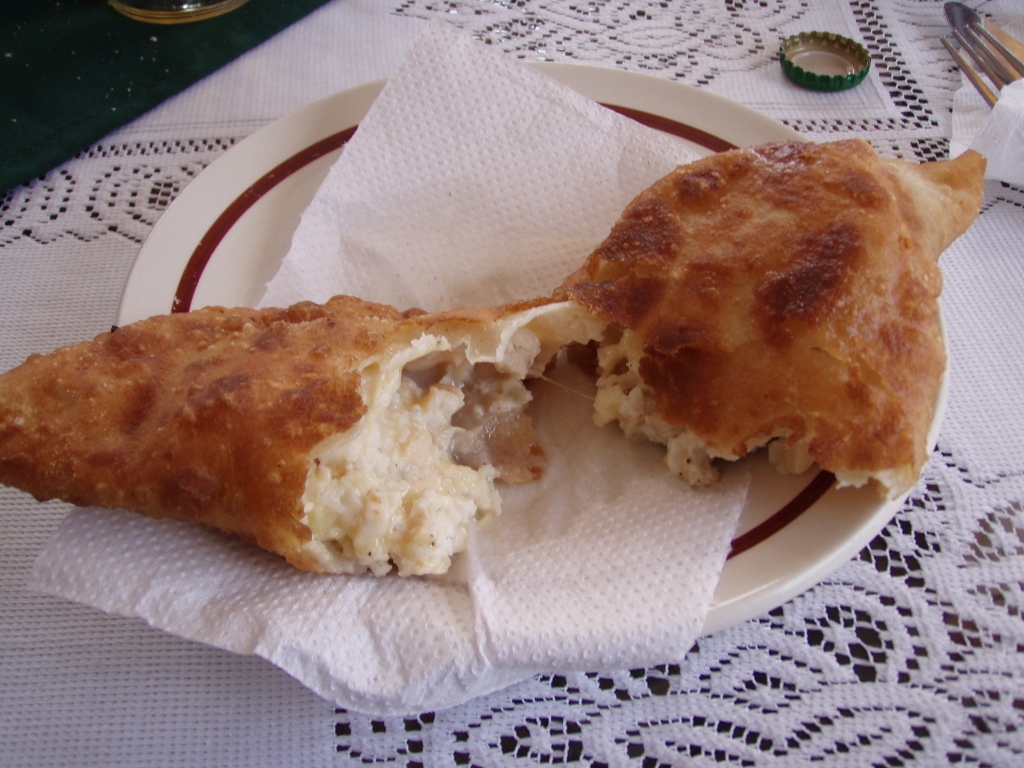 Empanadas with loco shells
Empanadas with loco shells
During the lunch, we were told that a grand-daughter of Pinochet was also having lunch at the restaurant. This turned out to be additionally curious since, after our return to La Serena, we heard news that Pinochet had died that very day (10 December 2006).
We didn’t dwell too much on the news, but rather went for a walk around the town, visiting the main square, as well as several of the numerous churches that exist in La Serena.
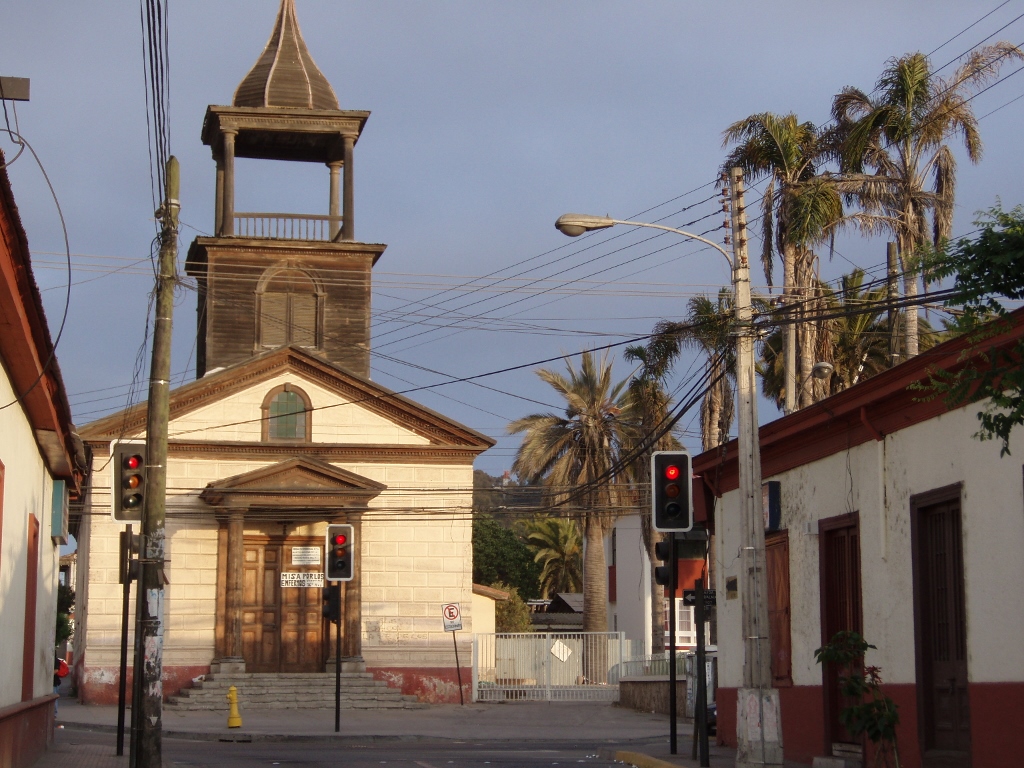 La Serena
La Serena
The next day we went for a whole-day excursion again, but this time we visited the valley of the Elqui river and some important places that are located there. The Elqui is a river springing in the Andes and relatively soon it flows into the Pacific. Its broad valley is exceptionally fertile and nowadays it is mainly used for growing grapevine. The valley is divided into four zones: the low valley (Valle Bajo) going up to 600 m a.s.l., medium valley (Valje Medio) (600-1000 m) which includes village Vicuña, high valley (Valje Alta) (1000 – 2000 m) and the fourth zone going from 2000 m to +/- 5000 m. This fourth zone is passed through went going to Argentina.
In the two lower valleys, people are very active in agriculture. In addition to the grapevine, there are other fruits and vegetables also grown there. By the way, at the time when I was in Chile, the main export products of the country were copper, fruits and salmon.
The tour first took us to a plantation with custard apple trees, which at this time of the year was almost without any leaves whatsoever, as well as with low papayas that already had fruits, but they were still rather small. Papaya may grow up to 4 to 5 metres in height and it grows rather fast.
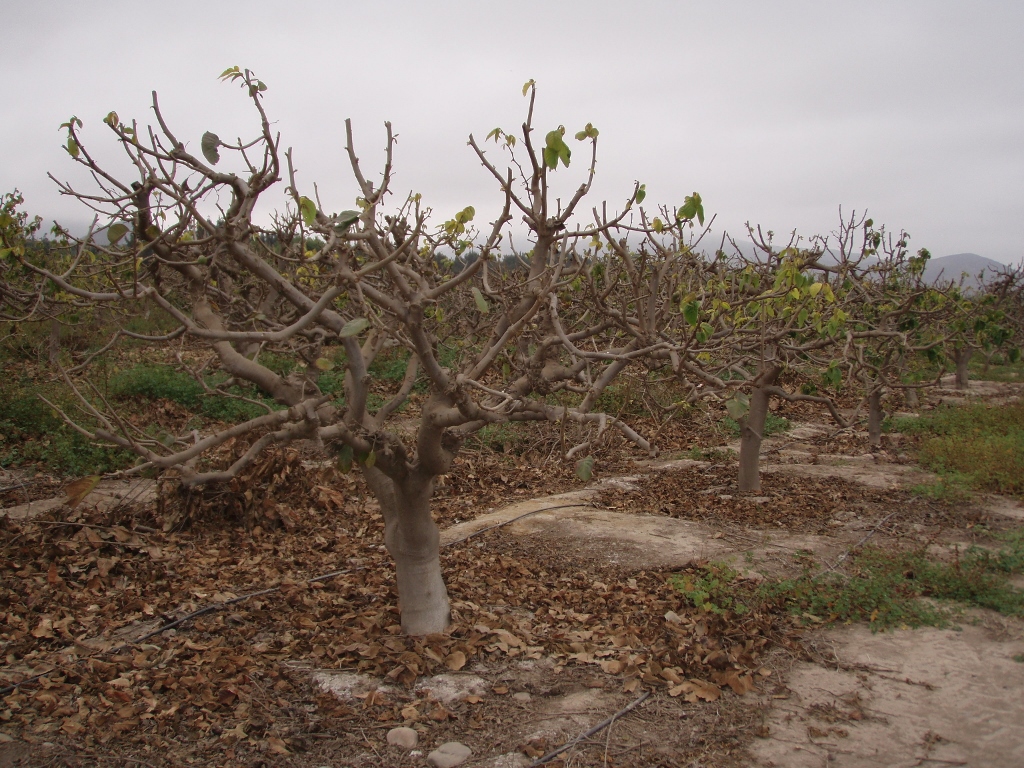 Custard apple plantation
Custard apple plantation
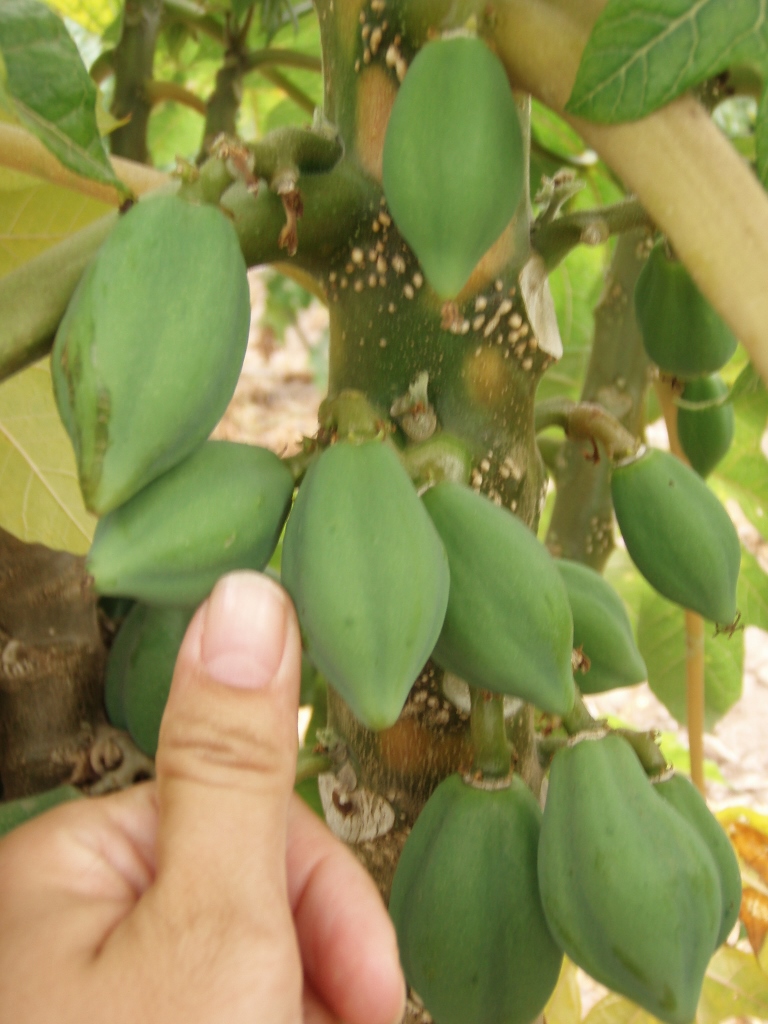 Tiny papayas
Tiny papayas
Then we went to village Vicuña in which Gabriela Mistral, the 1945 Literature Nobel Prize laureate, was born. There we had some free time to do some sightseeing, as well as to have a coffee. By this time, we had already been well versed in the types of coffee available and knew our preference. It was “cortado” and this was what we regularly ordered.
After the nice break, we started to walk around the main square, Plaza Gabriela Mistral, where there is the Bauer Tower built at the beginning of the 20th century after similar edifices constructed in Germany.
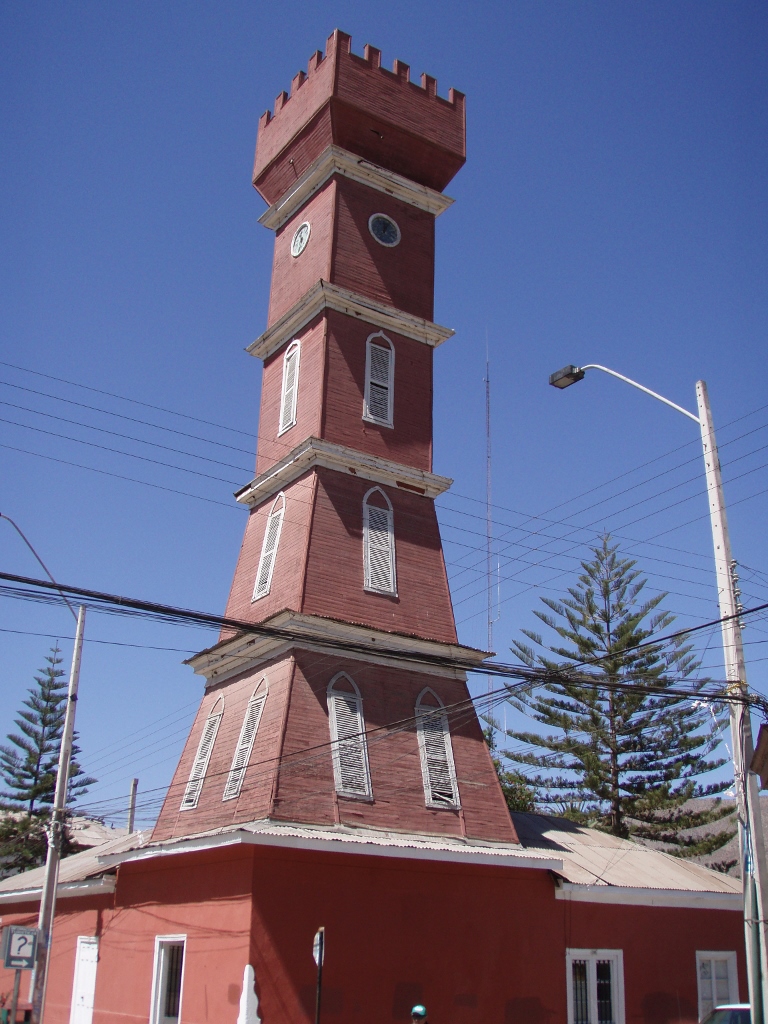 Vicuña , Bauer Tower
Vicuña , Bauer Tower
At the square, there is also the Church of the Immaculate Conception, Templo de la Inmaculada Concepcion.
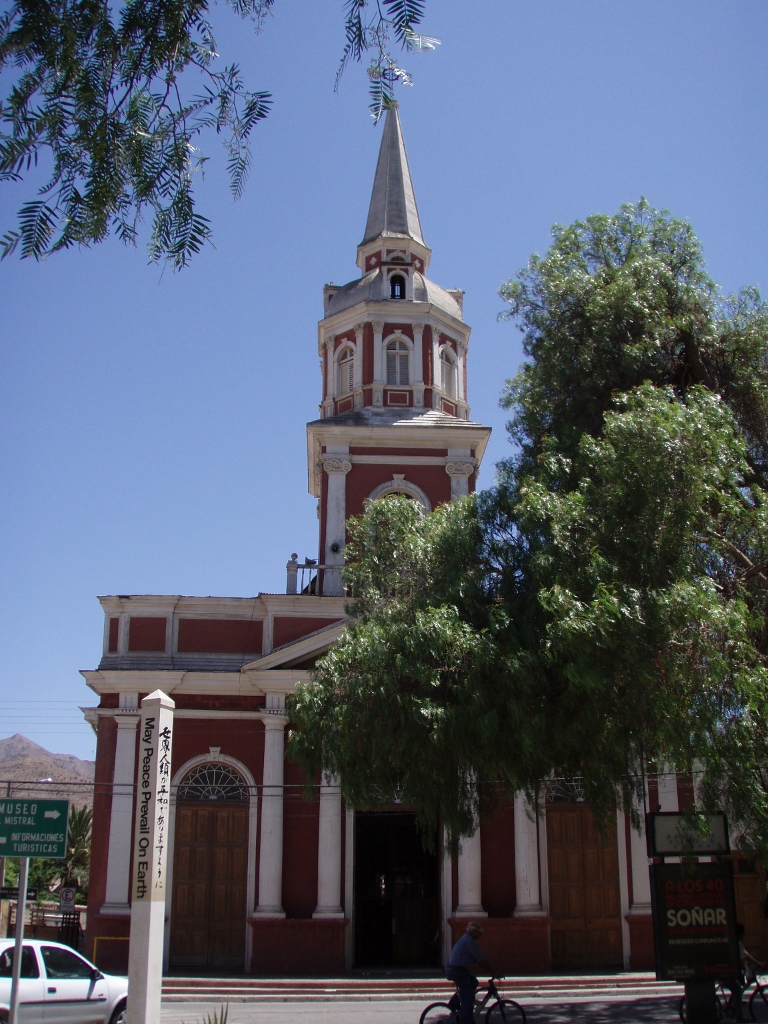 Vicuña , Church of the Immaculate Conception
Vicuña , Church of the Immaculate Conception
Still, more than the church itself, I was impressed by a board with instructions that was standing at the entrance into the church. It said: “Let’s respect and take care of this parish temple. Please do not enter the temple by car. Do not consume food, chewing gums or ice-cream. Turn off your mobile phone (you don’t need it to talk with God). Thank You!” And that’s all fine, but WHOEVER ENTERS A CHURCH IN A CAR??? Afterwards I was told that this word may also refer to a pushchair, but my first choice for its translation would certainly be “a car” and hence such degree of puzzlement on my part. I also don’t know what the first crossed drawing was supposed to mean. Perhaps “no pointless sketching”?
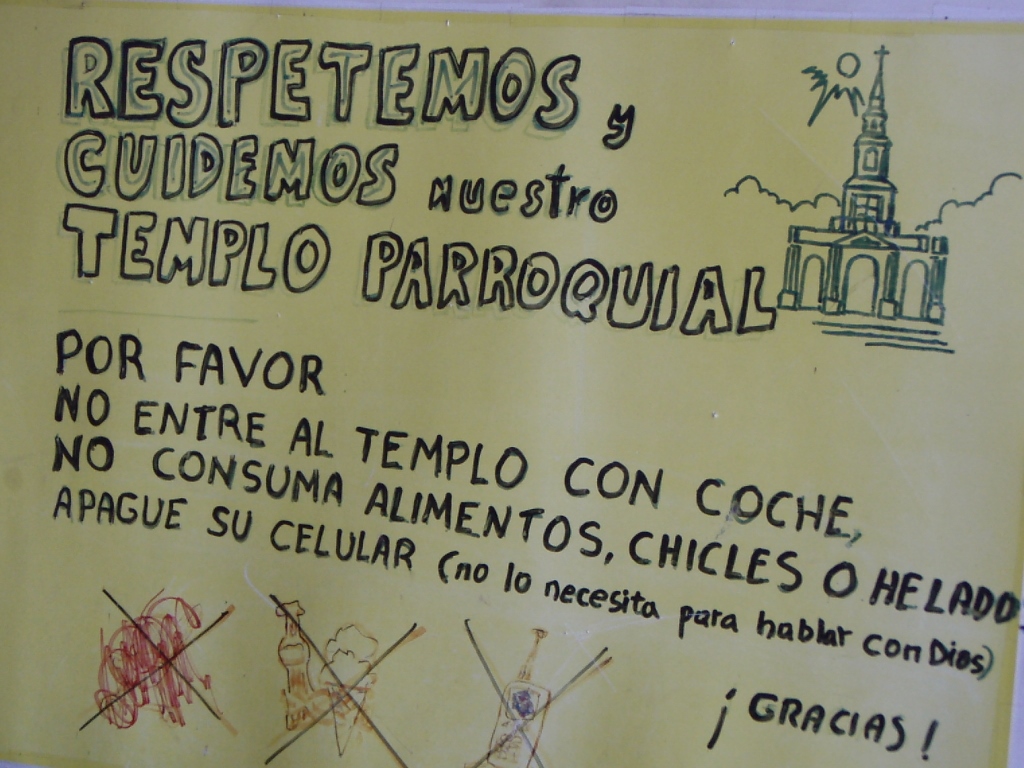 Vicuña , instructions for behaviour at the Church of the Immaculate Conception
Vicuña , instructions for behaviour at the Church of the Immaculate Conception
Further on, we passed through a couple of smaller villages. It is interesting that in some of them, the indigenous population, members of the Diaguita nation, have lived there in continuity for over 2000 years. The mountains that may be seen there is the so-called Chilean Coastal Range (Cordillera de la Costa), which in fact separates the coastal parts from the real Andes.
At some point we moved from the main valley into a side one. There we passed by plantations of grapes mostly earmarked for exports. By the way, there are three types of grapes grown here: for wine, for pisco and table grapes. Eventually we came to village Paihuano where we made a stop at some point and got out of the vehicle, since there were very nice views at the surrounding vineyards from there. I was truly impressed by how Chileans gradually manage to turn slowly the apparently barren slopes of the surrounding hills and mountains into fertile vineyards. In addition to spreading vineyards, the entrepreneurial Chileans have also started with forestation of those unproductive slopes, thus claiming the land from inhospitable nature piece by piece. VERY impressive indeed.
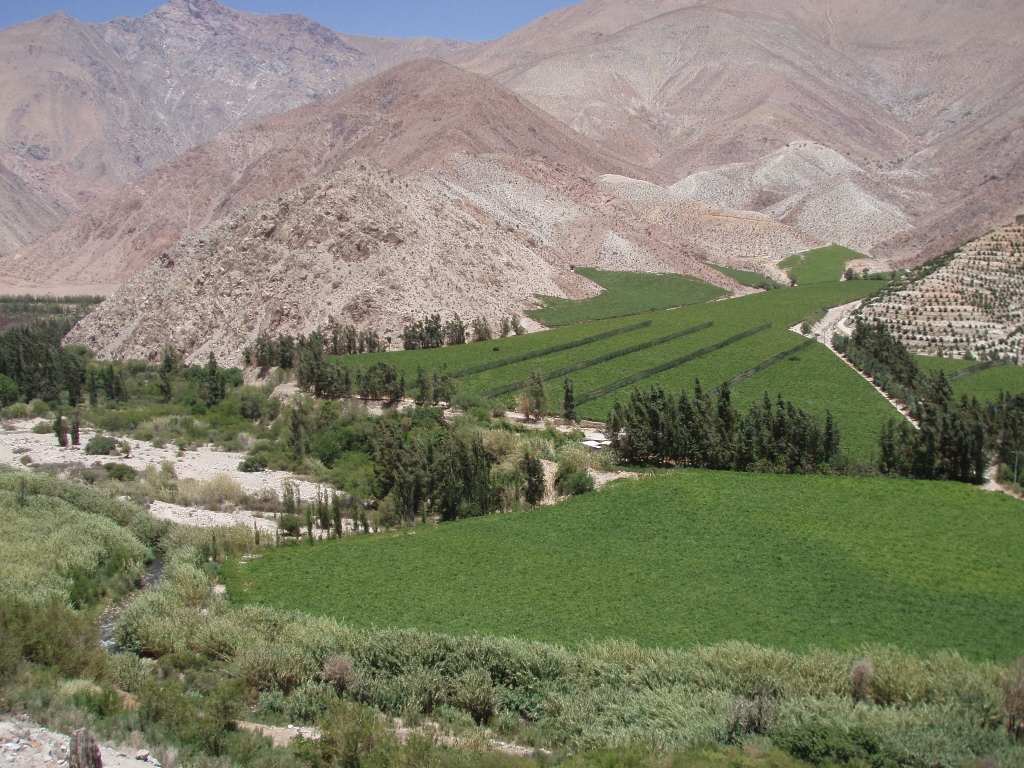 Paihuano, view at the vineyards which gradually “climb up” towards the peaks of the Chilean Coastal Range
Paihuano, view at the vineyards which gradually “climb up” towards the peaks of the Chilean Coastal Range
Then we continued towards the final destination of the day and that was village Pisco Elqui. Along the way we passed by yet another smaller valley called Cochiguaz that forked away from this side one. Somewhere at the end of that valley, 19 km away, some hippies founded a well-known commune in the 1960’s and 1970’s. Apparently, this is the place where the energies, vibrations, UFO sightings and all things extra-terrestrial are particularly good.
We skipped that, however, and went to Pisco Elqui where we saw a monument to Bernard O'Higgins (1778-1842) who was a famous Chilean general fighting for the liberation from the Spanish crown and whose name is often seen in the names of streets. Apparently, he has a famous saying “To live with honour or to die with glory!".
At Pisco Elqui we visited a distillery for the production of pisco and there we also saw a large avocado tree. The fruits were still small and unripe, but it was nice to see what they are actually growing on. There, in the shadow of some other trees we had a break for lunch, where among other things we also ate cazuela, a rather tasty typical dish of the Andes – a soup with large chunks of meat and vegetables.
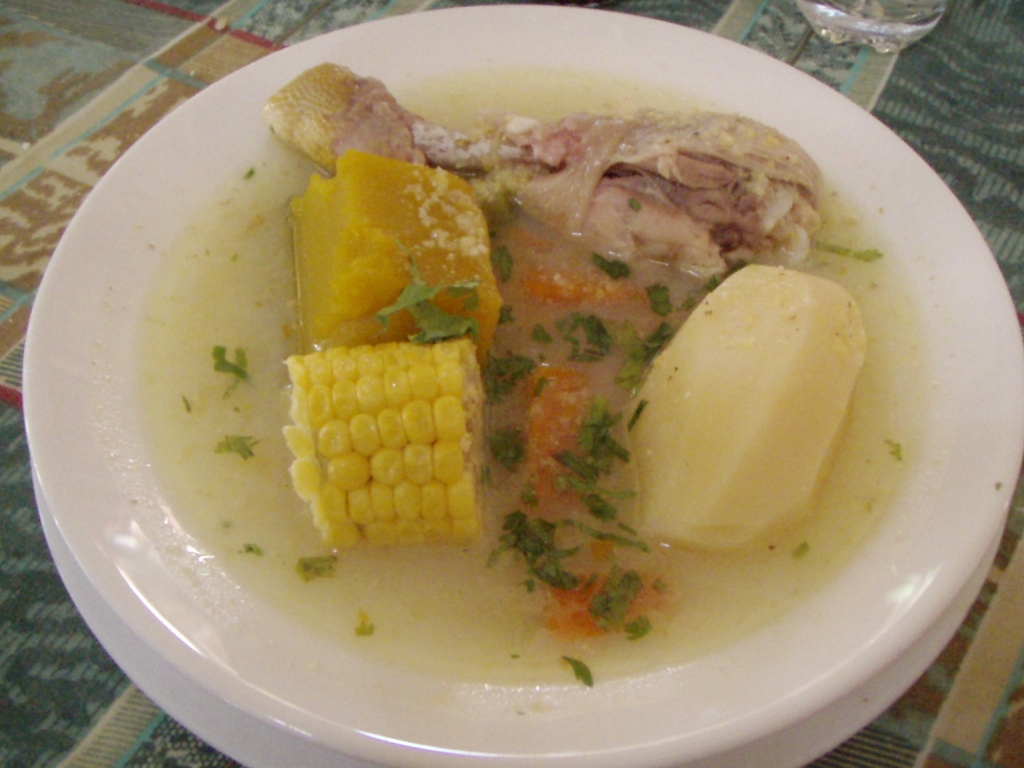 Cazuela – a soup with chicken, yucca, maize and potato
Cazuela – a soup with chicken, yucca, maize and potato
And then we started to go back, but along the way we stopped at village Monte Grande. It is famous for the fact that Gabriela Mistral used to work there as a teacher many years ago. Although she later lived and died in New York, at her expressed wish, she was buried precisely in Monte Grande and there we visited her tomb and the monument on it. Among other things, the monument also says: “What the soul does for its body, the artist does for his people” (Lo que el alma hace por su cuerpo, es lo que el artista hace por su pueblo).
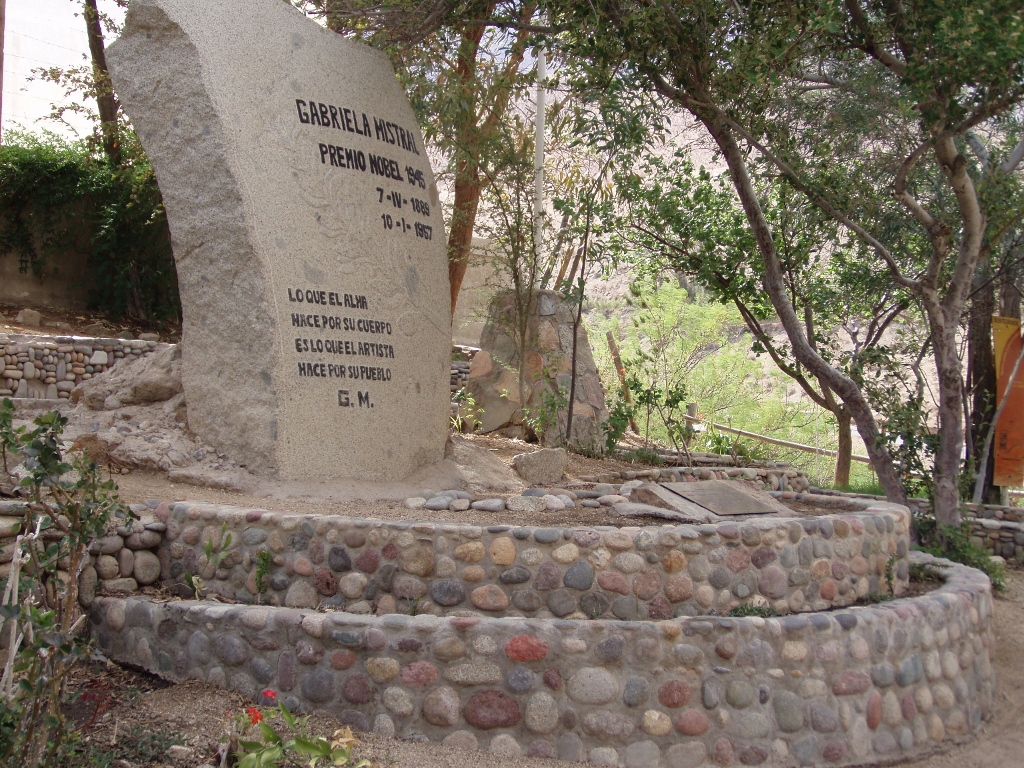 Monte Grande, Gabriela Mistral’s tomb
Monte Grande, Gabriela Mistral’s tomb
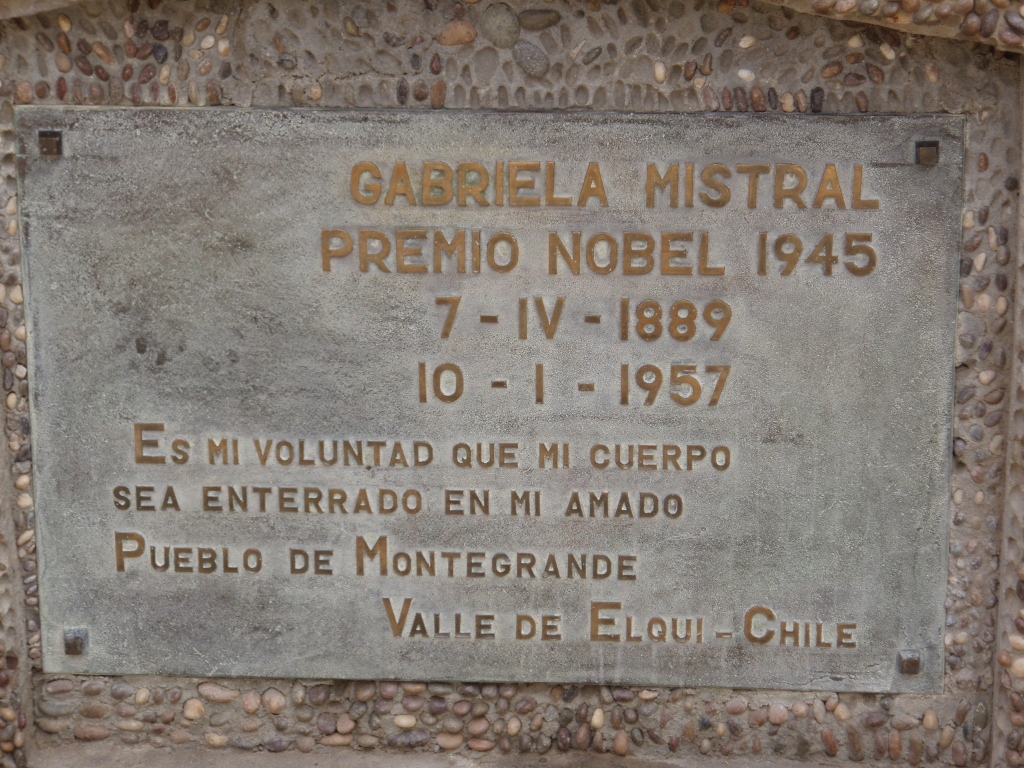 Monte Grande, Gabriela Mistral’s tomb. In addition to personal data, there is also: “It is my wish that my body is buried in my beloved village of Montegrande”
Monte Grande, Gabriela Mistral’s tomb. In addition to personal data, there is also: “It is my wish that my body is buried in my beloved village of Montegrande”
After this we went back to La Serena and from there, a little later, Sneza and I went to Santiago by another night coach. Then came the time for Sneza and I to part, since she had to go back home, while I stayed for another couple of weeks. The day after her departure I went in the completely opposite direction and that was west and to Easter Island that belongs to Chile.